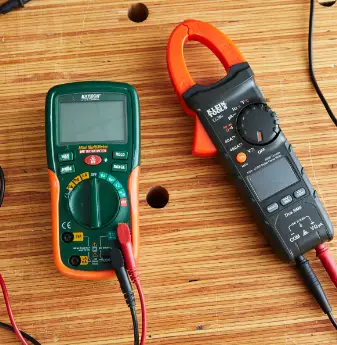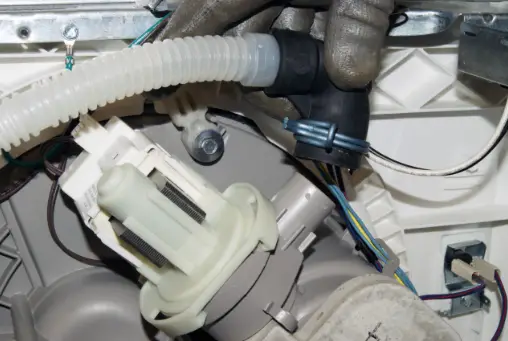
The drain pump in your dishwasher is essential for removing water from its drum after each wash cycle. In most dishwashers, including your GE appliance, it lies near the bottom. The position is strategic, so the pump can connect directly to the drain hose. To ensure the unit works, you must perform a GE dishwasher drain pump test.
Over time debris clog your dishwasher, making it difficult to drain. Also, the pump may experience continuity issues, leakage, and wear and tear. You must diagnose, repair, and test your dishwasher drain pump. GE dishwasher drain pump test includes the continuity test, leakage, blockage, and proper drainage, but first, unclog the drain assembly. So, what is the right way to conduct the test? Check out this guide.
Drain Pump Blockage Test
Dirty dishes have food debris that can clog your dishwasher drain. Check for blockage before testing the pump if the dishwasher isn’t draining well. Checking the drain pipe and filter for food debris will save you from an expensive and engaging testing process. You can also check for foreign items, such as pins and bones in the drain pump, as those could clog the unit. Here are the signs that your GE dishwasher drain has a blockage;
- bubbling sound
- Backing up water in the sink during and after the cycle
- Slow draining
- Dirty dishes
- Smelly unit
Unblocking your GE dishwasher first requires you to familiarize yourself with all the appliance parts. Next, have the plumping tools at hand to make work easier. These include a drain snake, screwdriver, cleaning aids (e.g., vinegar and baking soda), pliers, bucket, and gloves. You will also need a stiff brush to clean the sink gap.
Steps For Conducting A drain Pump Blockage Test
- Open the door and remove all the racks.
- Use the drain snake to flush the debris from the drain.
- Mix the cleaning aids and pour them into the drain.
- Locate the filter and rotate it clockwise to remove it.
- Clean all the debris and rotate it anticlockwise to fix it.
- Locate the sink gap and turn it counterclockwise to remove it.
- Use a stiff brush to clean out all debris.
- Locate the drain pipe at the back of the dishwasher and pull it from the wall to gain access.
- Inspect for kinks and bends, which could be causing proper draining.
- Loosen the clamp with pliers and collect water from the drain pipe.
- Examine for any debris and unclog.
- Use hot water to flush the hose. Ensure the water flows through.
- Mix the baking soda and vinegar to help you flush all the debris.
- If the hose has kinks, is broken, or has solid clogs, replace it with a new one. While reinstalling the pipe, maintain a high-rise loop to facilitate a perfect flow.
- Fix the drain back and run a hot rinse cycle.
What if unclogging the drain doesn’t improve the situation? Conduct a continuity test.
Drain Pump Continuity Test

Your GE dishwasher drain pump test also includes a continuity examination. This is to examine if the electrical flow is complete. If it is not done, the electric parts are broken, or the pump is defective. Once you test the pump and motor for continuity, you can analyze if there is a need for replacement or repair.
Step One: Accessing and Uninstalling The Drain Pump
- Shut off the power and water supply from the gadget.
- To access the lower panel (where the pump lies), unthread the screws and fasteners. Remove the panel and the insulation and set them aside.
- Unthread the water inlet valve.
- Unscrew the junction box cover and detach all the power and ground wires.
- Remove the power cord’s strain relief nut.
- Detach the drain hose from the garbage disposal or sink drain. Also, feed the drain hose through the cabinet.
- Unmount the screws that secure the dishwasher to the cabinet/countertop/floor.
- Raise the legs to lower the dishwasher and help you move the appliance.
- Pull it from the cabinet and tip it for better access.
- Uninstall the drain pump by detaching all the wires.
- Rotate the drain pump anticlockwise to release it from the sump.
Step Two: Testing The Drain Pump
- Grab your multimeter and attach the red meter terminal to one pump terminal and the black one to the other terminal.
- Read the multimeter. The pump has continuity if the readings are between 15 and 40 Ohms. If it is below or at zero, there is no continuity. You have to change the drain pump.
- Get a new pump and align it on the sump. Rotate it clockwise to fix it in place.
- Connect all the wires and return the unit to the correct position.
- Confirm that the end of the drainage hose is accessible through the cabinet wall and slide it into the cabinet and the sink drain or disposal. Ensure you elevate the hose above the connection point.
- Position the power cord in the junction box and thread the strain relief nut. Next, fix the grounding wire.
- Join other wires together and realign the junction cover. Reconnect the water inlet valve to the water supply.
- Reposition the racks.
- Reconnect power and water supply.
- Conduct a GE dishwasher drain pump test with a few dishes.
Drain Pump Leakage

Another issue that may prompt you to conduct a GE dishwasher drain pump test is leakage. Again, that happens when there is a problem with the dishwasher impeller, seal kit, or both.
First, you have to find out where the leak is coming from. It could be from the motor shaft area. That means the motor shaft seal is faulty. The only cure for defective seal is a replacement.
Your GE dishwasher manufacturer can help replace the seal. In most scenarios, the repair center will replace the impeller and seal or order an entire pump and motor assembly. It might be cost-effective to replace the whole pump assembly.
Final Words
GE dishwasher drain pump test includes checking for continuity, blockage, and leakage. A specific test may not give you the ideal answer to why your drain pump is failing. We have given you the procedure.
On our website, we advise you not to conduct tests you are not familiar with. If you are not conversant with the processes, leave the work to the professionals. Engaging in complex appliance repairs that you do not understand can cause more damage. Contact GE appliances for drain pump tests and other procedures. Good luck!

